The Effectiveness of “River Chief System” Policy: An Empirical Study Based on Environmental Monitoring Samples of China
Abstract
1. Introduction
2. Literature Review
3. Models and Data
3.1. Methods and Models
3.2. Index Design and Data Sources
4. Results
4.1. The Effectiveness of the RCS
4.2. Influencing Factors of Implementation Effect of RCS
5. Discussion
6. Conclusions
Supplementary Materials
Author Contributions
Funding
Institutional Review Board Statement
Informed Consent Statement
Data Availability Statement
Conflicts of Interest
References
- Mostert, E.; Pahl-Wostl, C.; Rees, Y.; Searle, B.; Tabara, J.D.; Tippett, J. Social learning in European river-basin management: Barriers and fostering mechanisms from 10 river basins. Ecol. Soc. 2007, 12, 1–16. [Google Scholar] [CrossRef]
- The Environment Agency. “Water for life and livelihoods, River Basin Management Plan, Thames River Basin District”. Available online: http://wfdconsultation.environment-gency.gov.uk/wfdcms/en/thames/Intro.aspx (accessed on 25 December 2020).
- CCTV News. The Songhua River has Been Heavily Polluted: Ministry of Ecology and Environment of the People’s Republic of China. 13 November 2005. Available online: http://www.cctv.com/news/special/C14973//index.shtml (accessed on 22 December 2020).
- Tao, M.; Xie, P.; Chen, J.; Qin, B.; Zhang, D.; Niu, Y.; Zhang, M.; Wang, Q.; Wu, L. Use of a generalized additive model to investigate key abiotic factors affecting microcystin cellular quotas in heavy bloom areas of Lake Taihu. PLoS ONE 2012, 7, e32020. [Google Scholar] [CrossRef] [PubMed]
- Ningguo News Network. The Water Pollution Incident in Yuehong Section of the Dongjin River Was Quickly Dealt with by Multi-Department Linkage: 11 May 2018. Available online: http://news.newsxc.com/xianshichuanzhen/ningguoxinwen/2018-05-11/352086.html (accessed on 22 December 2020).
- The National People’s Congress of the People’s Republic of China. Law of the People’s Republic of China on the Prevention and Control of Water Pollution. Available online: http://www.npc.gov.cn/npc/sjxflfg/201906/863e41b43f744efda56b14762e28dc6f.shtml (accessed on 22 December 2020).
- State Council of the People’s Republic of China. Regulations on the Management of the Taihu Basin. Available online: http://www.gov.cn/zhengce/2011-09/15/content_2602588.htm (accessed on 21 December 2020).
- The Central People’s Government of the People’s Republic of China. Regulations on the Prevention and Control of Water Pollution in the Danjiang River and the Hanjiang River in Shanxi Province. Available online: http://www.gov.cn/flfg/2005-12/16/content_129557.htm (accessed on 23 December 2020).
- Standing Committee of Jilin Provincial People’s Congress. Regulations on Water Environment Protection of Liaohe River Basin, Jilin Province. Available online: http://www.jlrd.gov.cn/xwzx/dfxfg/201908/t20190805_6022085.html (accessed on 20 December 2020).
- Boekhorst, D.G.J.T.; Smits, T.J.M.; Yu, X.; Li, L.; Lei, G.; Zhang, C. Implementing integrated river basin management in China. Ecol. Soc. 2010, 15, 23. [Google Scholar] [CrossRef]
- Ministry of Water Resources of the People’s Republic of China. Yangtse River Water Resources Commission of the Ministry of Water Resources of the People’s Republic of China. Available online: http://www.cjw.gov.cn/jgjs/cjwjj/ (accessed on 24 December 2020).
- Xu, H.F.; Wang, S. Study of an integrated river basin management model and its implications for river and lake management in China. Meteorol. Environ. Res. 2017, 8, 41–47. [Google Scholar] [CrossRef]
- Li, L.; Yan, R.; Xue, B. Methane levels of a river network in Wuxi City, China and response to water governance. Water 2020, 12, 2617. [Google Scholar] [CrossRef]
- Liu, D.; Richards, K. The He-Zhang (River chief/keeper) system: An innovation in China’s water governance and management. Int. J. River Basin Manag. 2018, 17, 263–270. [Google Scholar] [CrossRef]
- Ministry of Water Resources of the People’s Republic of China. We Will Comprehensively Promote the System of River and Lake Chiefs Policy. Available online: http://www.mwr.gov.cn/ztpd/gzzt/hzz/mtjj/201708/t20170811_973484.html (accessed on 25 December 2020).
- Ministry of Water Resources (“MWR”), P.R. China. Background Material of the Opinion on Comprehensively Promoting the River Chief System. Available online: http://www.china.com.cn/zhibo/zhuanti/ch-xinwen/2016-12/12/content_39896976.htm (accessed on 25 December 2020).
- Central People’s Government of the People’s Republic of China. The System of River Chiefs Was Fully Established. Available online: http://www.gov.cn/xinwen/2019-01/16/content_5358175.htm (accessed on 25 December 2020).
- China National Environmental Monitoring Centre. Water Quality Monitoring Data. Available online: http://www.cnemc.cn/sssj/ (accessed on 25 December 2020).
- Zhou, L.; Li, L.-Z.; Huang, J.-K. The river chief system and agricultural non-point source water pollution control in China. J. Integr. Agric. 2021, 20, 1382–1395. [Google Scholar] [CrossRef]
- Wang, L.; Tong, J.; Li, Y. River Chief System (RCS): An experiment on cross-sectoral coordination of watershed governance. Front. Environ. Sci. Eng. 2019, 13, 1–3. [Google Scholar] [CrossRef]
- Wyborn, C.; Bixler, R.P. Collaboration and nested environmental governance: Scale dependency, scale framing, and cross-scale interactions in collaborative conservation. J. Environ. Manag. 2013, 123, 58–67. [Google Scholar] [CrossRef]
- Wang, Y.; Chen, X. River chief system as a collaborative water governance approach in China. Int. J. Water Resour. Dev. 2019, 36, 610–630. [Google Scholar] [CrossRef]
- Ouyang, J.; Zhang, K.; Wen, B.; Lu, Y. Top-down and bottom-up approaches to environmental governance in China: Evidence from the River Chief System (RCS). Int. J. Environ. Res. Public Health 2020, 17, 7058. [Google Scholar] [CrossRef]
- List, J.; Bulte, E.; Shogren, J.F. “Beggar thy Neighbor:” testing for free riding in state-level endangered species expenditures. Public Choice 2002, 111, 303–315. [Google Scholar] [CrossRef]
- Sigman, H. Transboundary spillovers and decentralization of environmental policies. J. Environ. Econ. Manag. 2005, 50, 82–101. [Google Scholar] [CrossRef]
- Deng, Y.; Brombal, D.; Farah, P.D.; Moriggi, A.; Critto, A.; Zhou, Y.; Marcomini, A. China’s water environmental management towards institutional integration. A review of current progress and constraints vis-a-vis the European experience. J. Clean. Prod. 2016, 113, 285–298. [Google Scholar] [CrossRef]
- Bernauer, T.; Kuhn, P. Is there an environmental version of the Kantian peace? Insights from water pollution in Europe. Eur. J. Int. Relat. 2010, 16, 77–102. [Google Scholar] [CrossRef]
- Lipscomb, M.; Mobarak, A.M. Decentralization and pollution spillovers: Evidence from the re-drawing of county borders in Brazil. Rev. Econ. Stud. 2017, 84, 464–502. [Google Scholar] [CrossRef]
- Levinson, A. Environmental regulatory competition: A status report and some new evidence. Nat. Tax J. 2003, 56, 91–106. [Google Scholar] [CrossRef]
- Helland, E.; Whitford, A.B. Pollution incidence and political jurisdiction: Evidence from the TRI. J. Environ. Econ. Manag. 2003, 46, 403–424. [Google Scholar] [CrossRef]
- Greenstone, M.; Hanna, R. Environmental regulations, air and water pollution, and infant mortality in India. Am. Econ. Rev. 2011, 104, 3038–3072. [Google Scholar] [CrossRef]
- Kunrong, S.; Gang, J. The policy effects of the environmental governance of chinese local governments: A study based on the progress of the river chief system. Soc. Sci. China 2020, 41, 87–105. [Google Scholar] [CrossRef]
- Han, D.; Currell, M.J.; Cao, G. Deep challenges for China’s war on water pollution. Environ. Pollut. 2016, 218, 1222–1233. [Google Scholar] [CrossRef]
- Wang, H.; Mamingi, N.; Laplante, B.; Dasgupta, S. Incomplete enforcement of pollution regulation: Bargaining power of Chinese factories. Environ. Resour. Econ. 2003, 24, 245–262. [Google Scholar] [CrossRef]
- Varis, O.; Vakkilainen, P. China’s 8 challenges to water resources management in the first quarter of the 21st Century. Geomorphology 2001, 41, 93–104. [Google Scholar] [CrossRef]
- Zhang, Y.; Wang, S. How does policy innovation diffuse among Chinese local governments? A qualitative comparative analysis of River Chief Innovation. Public Adm. Dev. 2021, 41, 34–47. [Google Scholar] [CrossRef]
- Wu, C.; Ju, M.; Wang, L.; Gu, X.; Jiang, C. Public participation of the river chief system in China: Current trends, problems, and perspectives. Water 2020, 12, 3496. [Google Scholar] [CrossRef]
- Shen, M.H. Analysis on the River Chief System from the view of institutional economics. China Popul. Resour. Environ. 2018, 28, 134–139. [Google Scholar] [CrossRef]
- Liu, X.; Pan, Y.; Zhang, W.; Ying, L.; Huang, W. Achieve Sustainable development of rivers with water resource management—Economic model of river chief system in China. Sci. Total. Environ. 2020, 708, 134657. [Google Scholar] [CrossRef]
- She, Y.; Liu, Y.; Jiang, L.; Yuan, H. Is China’s River Chief Policy effective? Evidence from a quasi-natural experiment in the Yangtze River Economic Belt, China. J. Clean. Prod. 2019, 220, 919–930. [Google Scholar] [CrossRef]
- Li, Y.; Tong, J.; Wang, L. Full implementation of the River Chief System in China: Outcome and weakness. Sustainability 2020, 12, 3754. [Google Scholar] [CrossRef]
- Li, J.; Shi, X.; Wu, H.; Liu, L. Trade-off between economic development and environmental governance in China: An analysis based on the effect of river chief system. China Econ. Rev. 2020, 60, 101403. [Google Scholar] [CrossRef]
- Liu, H.; Chen, Y.D.; Liu, T.; Lin, L. The River Chief System and river pollution control in China: A case study of Foshan. Water 2019, 11, 1606. [Google Scholar] [CrossRef]
- Fischer, F.A. Reframing Public Policy: Discursive Politics and Deliberative Practices; Oxford University Press: Oxford, UK, 2003; pp. 105–107. [Google Scholar]
- Ying, L.; Shen, Z.; Piao, S. The recent hiatus in global warming of the land surface: Scale-dependent breakpoint occurrences in space and time. Geophys. Res. Lett. 2015, 42, 6471–6478. [Google Scholar] [CrossRef]
- McCrary, J. Manipulation of the running variable in the regression discontinuity design: A density test. J. Econ. 2008, 142, 698–714. [Google Scholar] [CrossRef]
- Chen, Z.; Kahn, M.E.; Liu, Y.; Wang, Z. The consequences of spatially differentiated water pollution regulation in China. J. Environ. Econ. Manag. 2018, 88, 468–485. [Google Scholar] [CrossRef]
- Demirbilek, B.; Benson, D. Between emulation and assemblage: Analysing WFD policy transfer outcomes in Turkey. Water 2019, 11, 324. [Google Scholar] [CrossRef]
- Zhou, Q.; Wang, Y.; Zeng, M.; Jin, Y.; Zeng, H. Does China’s river chief policy improve corporate water disclosure? A quasi-natural experimental. J. Clean. Prod. 2021, 311, 127707. [Google Scholar] [CrossRef]
- Roy, M.; Chakraborty, S. Developing a sustainable water resource management strategy for a fluoride-affected area: A contingent valuation approach. Clean Technol. Environ. Policy 2013, 16, 341–349. [Google Scholar] [CrossRef]
- Fu, Y.; Zhang, J.; Zhang, C.; Zang, W.; Guo, W.; Qian, Z.; Liu, L.; Zhao, J.; Feng, J. Payments for ecosystem services for watershed water resource allocations. J. Hydrol. 2018, 556, 689–700. [Google Scholar] [CrossRef]
- Jiang, M.; Shen, X.; Wang, Y.; Wang, L. Evaluation and temporal—Spatial differences of the effectiveness of the river chief system in Jiangsu Province. South-to-North Water Transfer. Water Sci. Technol. 2018, 16, 201–208. (In Chinese) [Google Scholar]
- Rahm, D.; Swatuk, L.; Matheny, E. Water resource management in Botswana: Balancing sustainability and economic development*. Environ. Dev. Sustain. 2006, 8, 157–183. [Google Scholar] [CrossRef]
- Zhang, Y.; Sun, M.; Yang, R.; Li, X.; Zhang, L.; Li, M. Decoupling water environment pressures from economic growth in the Yangtze River Economic Belt, China. Ecol. Indic. 2021, 122, 107314. [Google Scholar] [CrossRef]
- Trinh, A.D.; Georges, V.; Marie, P.B.; Nicolas, P.; Vu, D.L.; Le, L.A. Experimental investigation and modelling approach of the impact of urban wastewater on a tropical river; A case study of the Nhue River, Hanoi, Viet Nam. J. Hydrol. 2007, 334, 347–358. [Google Scholar] [CrossRef]
- Hahn, J.; Todd, P.; Klaauw, W. Identification and estimation of treatment effects with a regression-discontinuity design. Econometrica 2001, 69, 201–209. [Google Scholar] [CrossRef]
- Ministry of Ecology and Environment, PRC China. Environmental Quality Standard for Surface Water GB3838-200; National Health Commission of the People’s Republic of China: Beijing, China, 2002; pp. 3–5.
- Fu, J.; Zhao, C.; Luo, Y.; Liu, C.; Kyzas, G.; Luo, Y.; Zhao, D.; An, S.; Zhu, H. Heavy metals in surface sediments of the Jialu River, China: Their relations to environmental factors. J. Hazard. Mater. 2014, 270, 102–109. [Google Scholar] [CrossRef] [PubMed]
- Bao, H.; Wang, C.; Han, L.; Wu, S.; Lou, L.; Xu, B.; Liu, Y. Resources and environmental pressure, carrying capacity, and governance: A case study of Yangtze River Economic Belt. Sustainability 2020, 12, 1576. [Google Scholar] [CrossRef]
- Jiang, S.-S.; Li, J.-M. Do political promotion incentive and fiscal incentive of local governments matter for the marine environmental pollution? Evidence from China’s coastal areas. Mar. Policy 2021, 128, 104505. [Google Scholar] [CrossRef]
- Chang, H. Spatial analysis of water quality trends in the Han River basin, South Korea. Water Res. 2008, 42, 3285–3304. [Google Scholar] [CrossRef]
- Cruz, M.C.; Meyer, C.A.; Repetto, R.; Woodward, R. Population Growth, Poverty, and Environmental Stress: Frontier Migration in the Philippines and Costa Rica; World Resources Institute: Washington, DC, USA, 1992; pp. 85–101. [Google Scholar]
- Imbens, G.; Kalyanaraman, K. Optimal bandwidth choice for the regression discontinuity estimator. Rev. Econ. Stud. 2012, 79, 933–959. [Google Scholar] [CrossRef]
- Cramer, V.; Torgersen, S.; Kringlen, E. Quality of life in a city: The effect of population density. Soc. Indic. Res. 2004, 69, 103–116. [Google Scholar] [CrossRef]
- Nobel, C.E.; McDonald-Buller, E.C.; Kimura, Y.; Lumbley, K.E.; Allen, D.T. Influence of population density and temporal variations in emissions on the air quality benefits of NOxEmission trading. Environ. Sci. Technol. 2002, 36, 3465–3473. [Google Scholar] [CrossRef][Green Version]
- Gleeson, T.; Wada, Y.; Bierkens, M.F.; Van Beek, L.P.H. Water balance of global aquifers revealed by groundwater footprint. Nature 2012, 488, 197–200. [Google Scholar] [CrossRef]
- Chitakira, M.; Nyikadzino, B. Effectiveness of environmental management institutions in sustainable water resources management in the upper Pungwe River basin, Zimbabwe. Phys. Chem. Earth Parts A/B/C 2020, 118–119, 102885. [Google Scholar] [CrossRef]
- Zhang, C.; Shen, Y.; Li, Q.; Jia, W.; Li, J.; Wang, X. Sediment grain–size characteristics and relevant correlations to the aeolian environment in China’s eastern desert region. Sci. Total. Environ. 2018, 627, 586–599. [Google Scholar] [CrossRef]
- Prokopy, L.S.; Mullendore, N.; Brasier, K.; Floress, K. A typology of catalyst events for collaborative watershed management in the United States. Soc. Nat. Resour. 2014, 27, 1177–1191. [Google Scholar] [CrossRef]
- Takahasi, Y.; Uitto, J.I. Evolution of river management in Japan: From focus on economic benefits to a comprehensive view. Glob. Environ. Chang. 2004, 14, 63–70. [Google Scholar] [CrossRef]
- Astrid, O.; Ron, C. Learning from the past; Changing perspectives on river management in the Netherlands. Environ. Sci. Policy 2012, 15, 13–22. [Google Scholar] [CrossRef]
- Räsänen, A.; Schönach, P.; Jurgilevich, A.; Heikkinen, M.; Juhola, S. Role of Transformative capacity in river basin management transformations. Water Resour. Manag. 2018, 33, 303–317. [Google Scholar] [CrossRef]
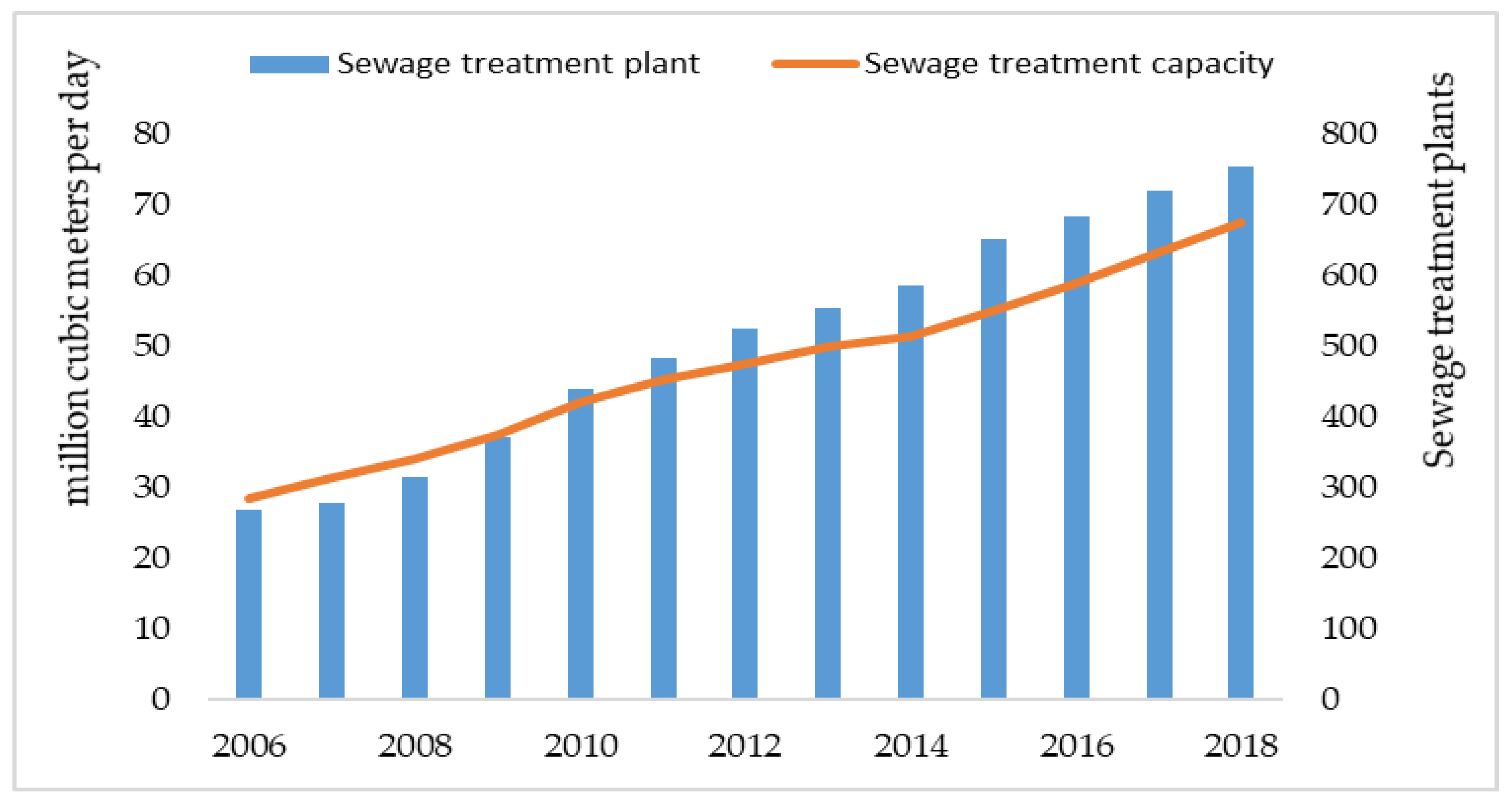
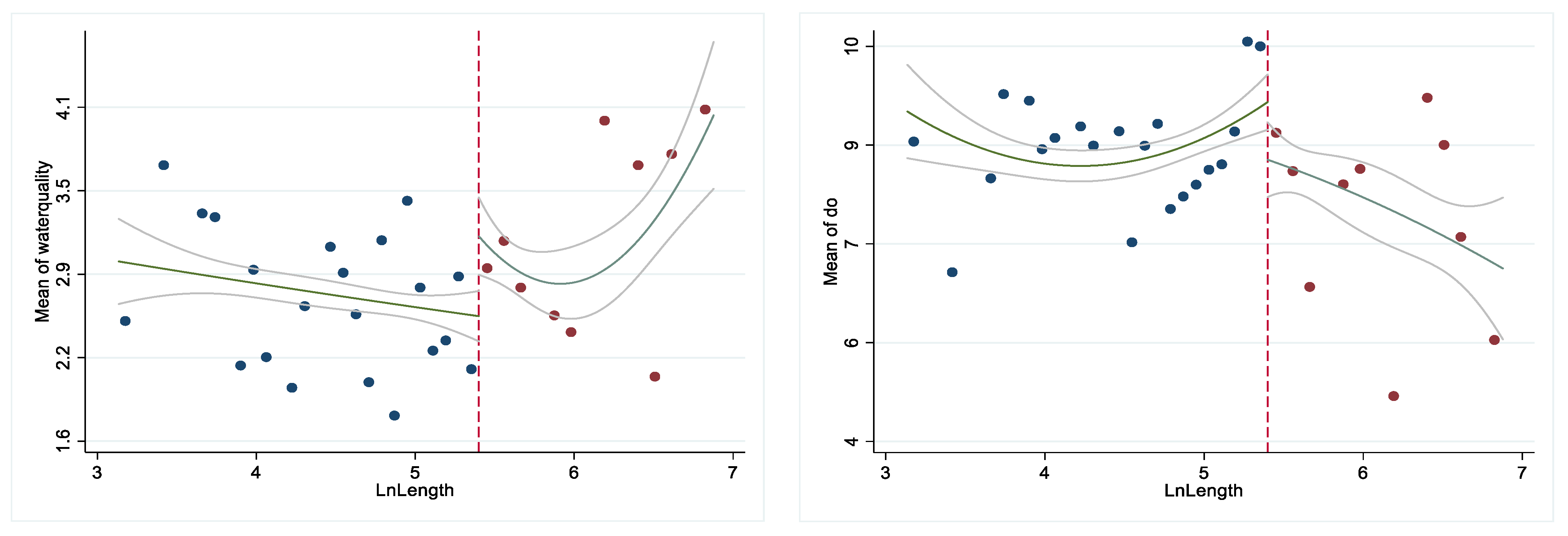
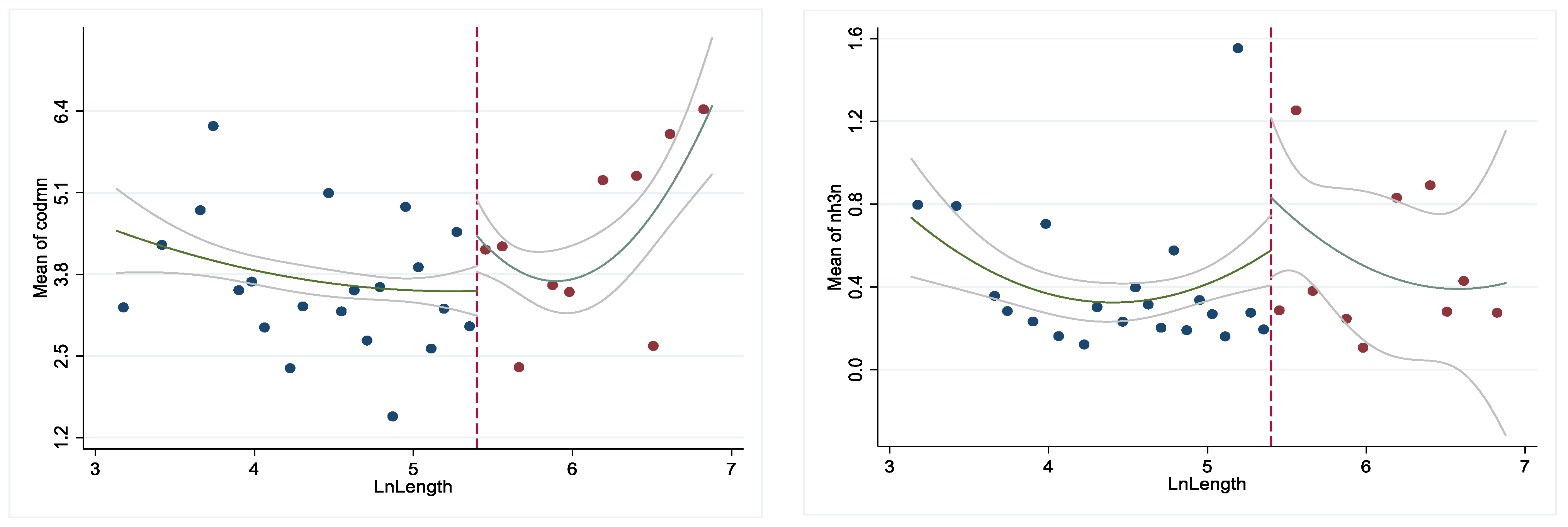
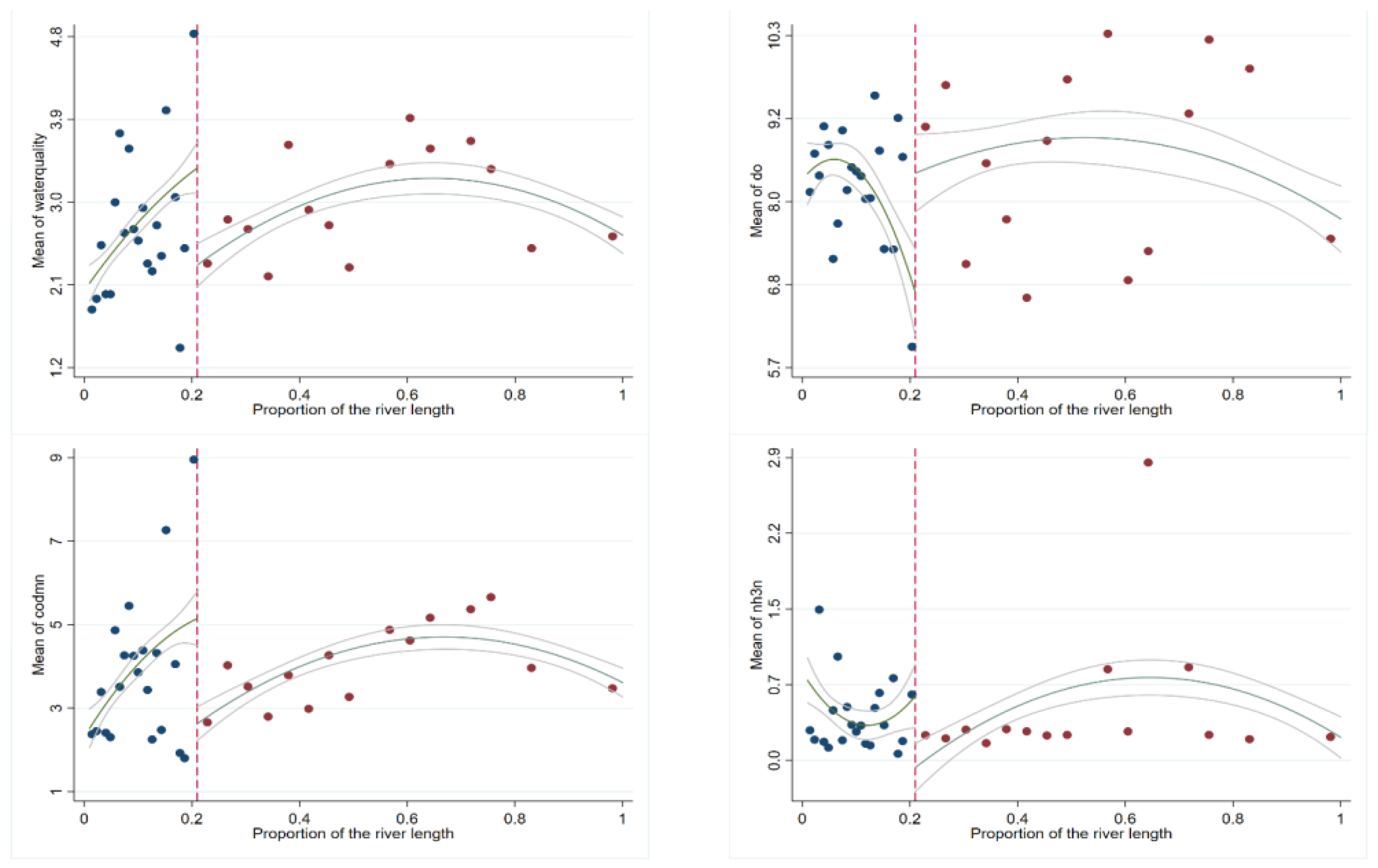
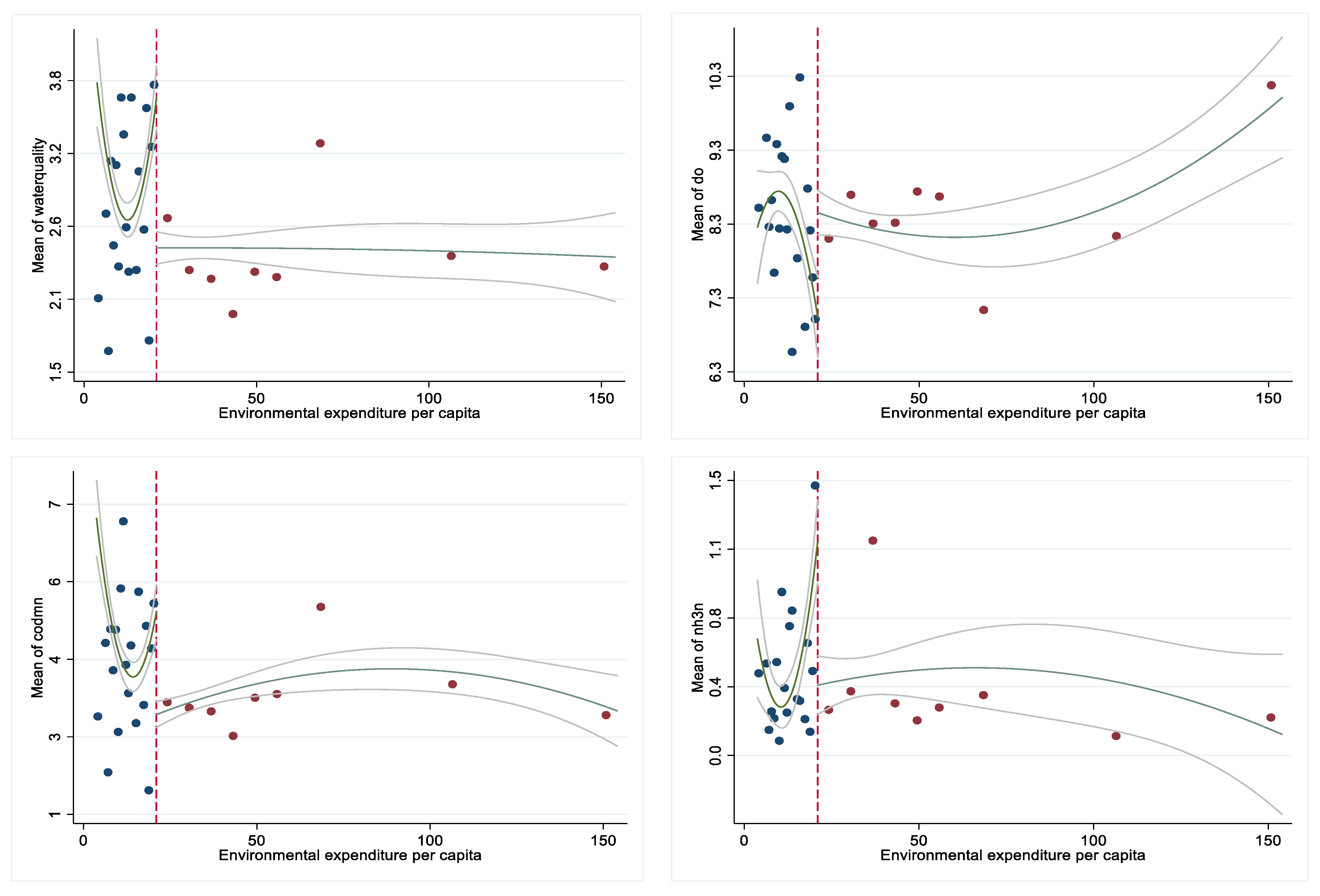
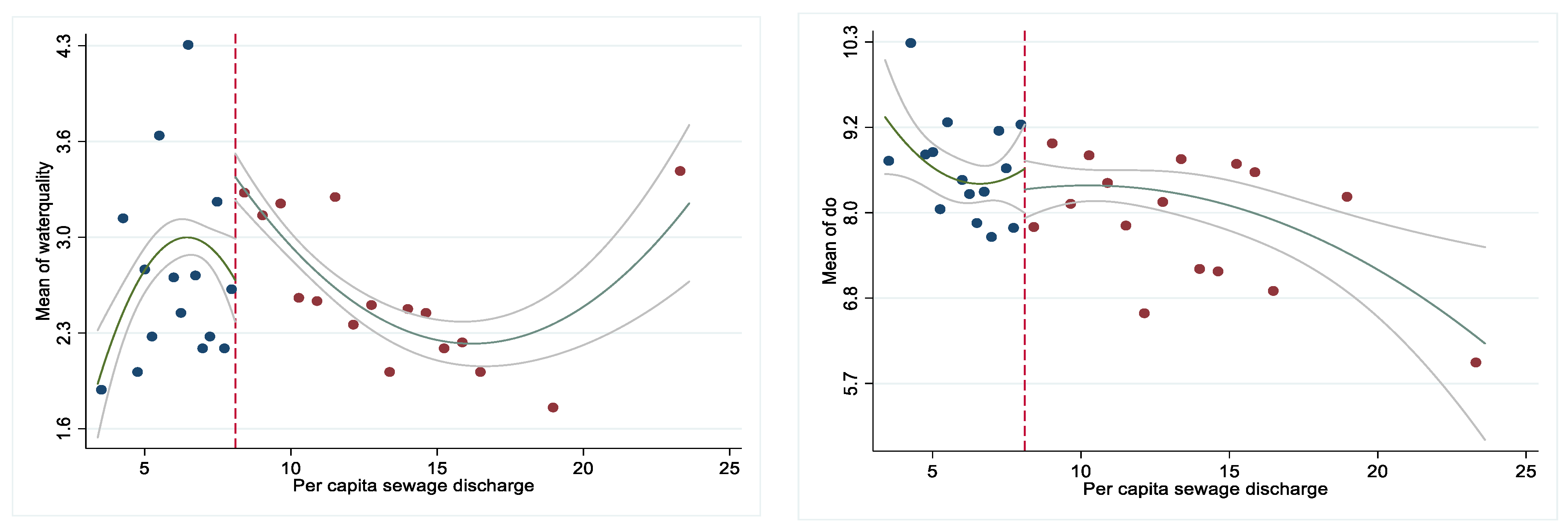

| Water Quality Standard | Level Ⅰ | Level Ⅱ | Level Ⅲ | Level Ⅳ | Level Ⅴ |
|---|---|---|---|---|---|
| ≥ | 7.50 | 6.00 | 5.00 | 3.00 | 2.00 |
| ≤ | 0.15 | 0.50 | 1.00 | 1.50 | 2.00 |
| ≤ | 2.00 | 4.00 | 6.00 | 10.00 | 15.00 |
| Variable | Measurement | N | Ave | Std. | Min. | Max. |
|---|---|---|---|---|---|---|
| Comprehensive water quality (CWQ) | - | 820 | 2.96 | 1.14 | 1 | 6 |
| mg/L | 820 | 7.72 | 1.69 | 1.39 | 12.22 | |
| mg/L | 820 | 4.31 | 2.95 | 0.95 | 30.35 | |
| mg/L | 820 | 0.68 | 1.25 | 0.03 | 12.82 | |
| Annual average temperature | °C | 820 | 14.79 | 4.87 | −2.2 | 24 |
| Annual rainfall | mm | 820 | 991.2 | 483.40 | 39.50 | 3.01 |
| Sewage treatment plant | unit | 820 | 7.49 | 0.40 | 0 | 67 |
| Sewage treatment capacity | 10,000 CBM a day | 820 | 67.73 | 4.20 | 0 | 821 |
| Variable | Measurement | N | Ave | Std. | Min. | Max. |
|---|---|---|---|---|---|---|
| Comprehensive water quality (CWQ) | - | 1032 | 2.76 | 1.08 | 1.00 | 6.00 |
| mg/L | 1032 | 8.34 | 2.34 | 0.70 | 18.75 | |
| mg/L | 1032 | 3.83 | 2.23 | 0.70 | 18.53 | |
| mg/L | 1032 | 0.46 | 1.09 | 0.02 | 14.73 | |
| Logarithm of the river length | - | 1032 | 4.82 | 0.77 | 3.14 | 6.88 |
| Proportion of the river length | - | 1032 | 0.314 | 0.312 | 0.01 | 1 |
| Environmental expenditure per capita | RMB per person | 1032 | 27.06 | 26.03 | 3.77 | 153.9 |
| Per capita sewage discharge | CBM per person | 1032 | 9.564 | 3.60 | 3.40 | 23.62 |
| Mean monthly temperature | °C | 1032 | 13.94 | 11.75 | −26.40 | 30.30 |
| Monthly rainfall | mm | 1032 | 79.85 | 90.87 | 0.00 | 710.30 |
| Sewage treatment plant | unit | 1032 | 8.83 | 13.71 | 1 | 67 |
| Sewage treatment capacity | 10,000 CBM a day | 1032 | 72.55 | 129.26 | 2.05 | 670.55 |
| Estimator | CWQ | |||
|---|---|---|---|---|
| No covariates added | −0.22 *** (0.06) | 0.45 *** (0.13) | −0.55 ** (0.24) | −0.36 *** (0.12) |
| covariates added | −0.18 ** (0.06) | 0.42 ** (0.14) | −0.47 * (0.25) | −0.32 * (0.12) |
| N | 820 | 820 | 820 | 820 |
| Estimator | CWQ | |||
|---|---|---|---|---|
| Administrative scopes (AS) (km) | 0.7 *** (0.16) | −1.51 ** (0.64) | 1.87 ** (0.37) | −0.48 ** (0.22) |
| 5.4 | 5.4 | 5.4 | 5.4 | |
| Administrative conflicts (AC) | −0.954 *** (0.19) 0.21 | 2.386 *** (0.51) 0.21 | −2.143 *** (0.48) 0.21 | −0.302 *** (0.08) 0.21 |
| Environmental spending capacity (ESC) (RMB/person) | −1.30 *** (0.26) | 1.03 * (0.57) | −2.37 *** (0.53) | −2.77 *** (0.82) |
| 21 | 21 | 21 | 21 | |
| Environmental pressure (EP) (CBM/person) | 1.20 *** (0.24) | −2.41 *** (0.62) | 1.03 ** (0.50) | 0.31 *** (0.11) |
| 8.1 | 8.1 | 8.1 | 8.1 | |
| Covariables | No | No | No | No |
| N | 1032 | 1032 | 1032 | 1032 |
Publisher’s Note: MDPI stays neutral with regard to jurisdictional claims in published maps and institutional affiliations. |
© 2021 by the authors. Licensee MDPI, Basel, Switzerland. This article is an open access article distributed under the terms and conditions of the Creative Commons Attribution (CC BY) license (https://creativecommons.org/licenses/by/4.0/).
Share and Cite
Li, W.; Zhou, Y.; Deng, Z. The Effectiveness of “River Chief System” Policy: An Empirical Study Based on Environmental Monitoring Samples of China. Water 2021, 13, 1988. https://doi.org/10.3390/w13141988
Li W, Zhou Y, Deng Z. The Effectiveness of “River Chief System” Policy: An Empirical Study Based on Environmental Monitoring Samples of China. Water. 2021; 13(14):1988. https://doi.org/10.3390/w13141988
Chicago/Turabian StyleLi, Wanhua, Yaodong Zhou, and Zhijia Deng. 2021. "The Effectiveness of “River Chief System” Policy: An Empirical Study Based on Environmental Monitoring Samples of China" Water 13, no. 14: 1988. https://doi.org/10.3390/w13141988
APA StyleLi, W., Zhou, Y., & Deng, Z. (2021). The Effectiveness of “River Chief System” Policy: An Empirical Study Based on Environmental Monitoring Samples of China. Water, 13(14), 1988. https://doi.org/10.3390/w13141988





